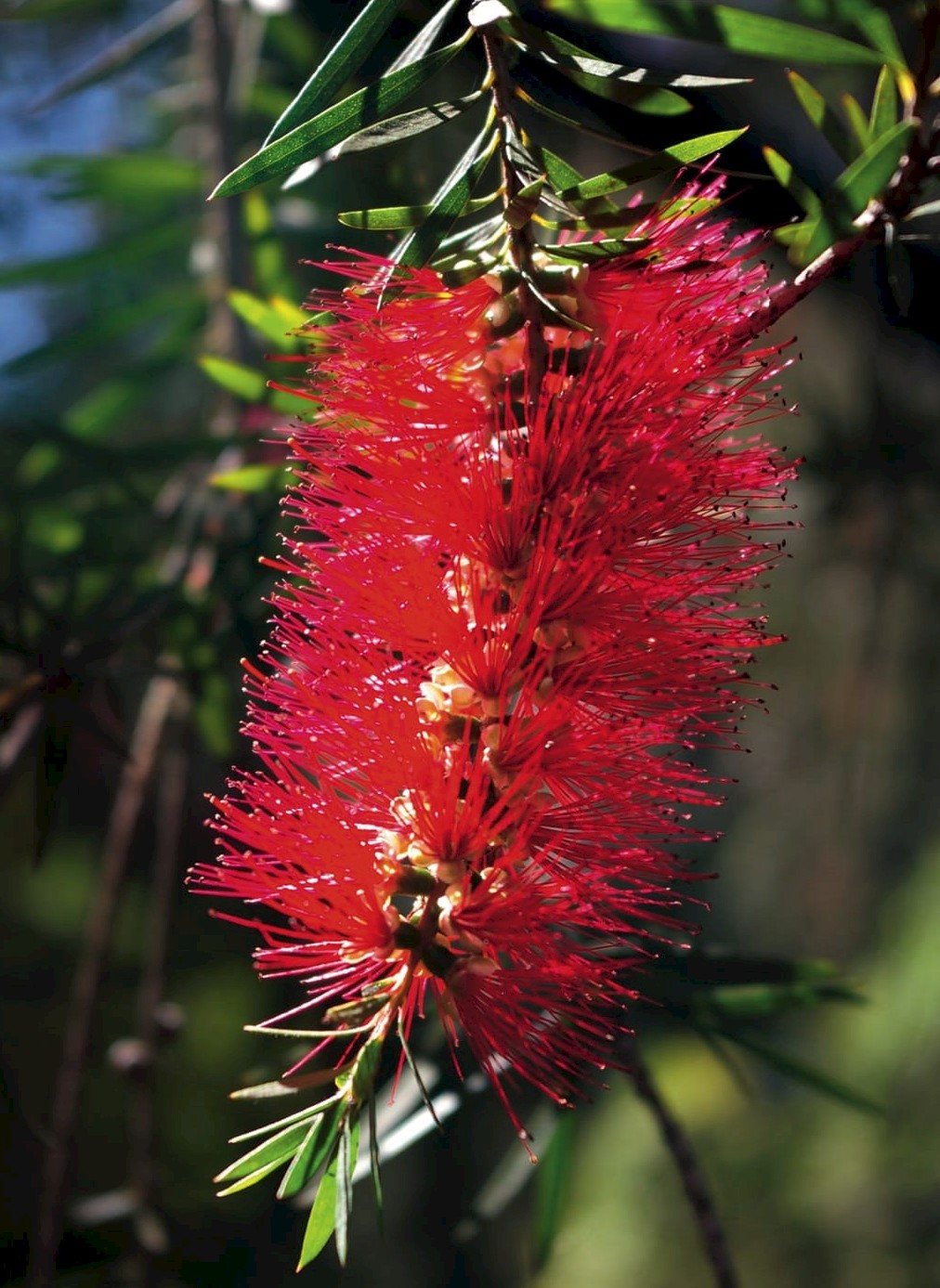Callistemon
Credits
Article from Bean's Trees and Shrubs Hardy in the British Isles
Article from New Trees by John Grimshaw & Ross Bayton
Recommended citation
'Callistemon' from the website Trees and Shrubs Online (treesandshrubsonline.
Family
- Myrtaceae
Common Names
- Bottlebrushes
The 35 species of Callistemon are endemic to Australia; the genus is closely related to Melaleuca L. (Brown et al. 2001). They are spreading shrubs or small trees with stiff, evergreen foliage. The leaves are alternate, entire, sessile or shortly petiolate; immature growth is often pinkish red and usually covered in silky hairs. The flowers are sessile and amassed along the stem in several parallel rows, forming the ‘bottlebrush’; the stem continues to grow before or after flowering, producing a leafy shoot beyond the inflorescence. The flowers are hermaphrodite and 5-merous; the sepals circular, fused to the bell- or urn-shaped hypanthium; the petals circular, longer than the sepals, greenish yellow, white, pink or purple; the stamens numerous, conspicuous, much longer than the petals, free (not in bundles as in Melaleuca), white, cream, yellow, pink, mauve, red or purple. The fruit is a sessile, woody capsule that may persist on the plant for many years; fire may be the stimulus that causes the capsules to open (Elliot & Jones 1982, Mitchem 1993, Spencer & Lumley 2002).
Callistemon is another genus to have benefited in recent years from both the warmer climate and the greater inclination of gardeners to experiment, as several species and cultivars are now frequently to be seen in both public and private gardens throughout the United Kingdom. Many of these are short shrubby taxa, and few have achieved great size as yet, but the caution with which Bean (1976a) tentatively discussed them would not need to be repeated in a modern reference. They add a great deal of interest to the summer garden and are a welcome addition to the normal horticultural landscape, not only for the British Isles but for anywhere in milder parts of western Europe and the American West Coast. Few, however, form trees in our area, and of taxa not described by Bean, only C. viminalis is of tree-stature in its wild habitats. A warm, dry situation will give Callistemon the best chance of success; they seem to tolerate at least moderately alkaline conditions, but neutral to slightly acidic soil is probably preferable. Seedlings are easy to raise in moist, humid conditions but the species are prone to hybridise, so selected clones should be propagated by semi-ripe cuttings in late summer.
The related genus Melaleuca (honeymyrtles, paperbarks, tea trees), comprising about 250 species, is also receiving attention at present, with northern temperate gardeners investigating the horticultural potential of this diverse group. The majority of species are rather shrubby, but with their white, yellowish green, yellow, pink, purple or red flowers they are attractive and interesting plants to experiment with in warm, well-drained sites on acidic soil. That the experiment is fully in progress is demonstrated by the listing in the RHS Plant Finder 2007–2008 of 40 species available in British nurseries. Elliot and Jones (1993) state that in Australian conditions the following (mostly shrubby) species have survived temperatures of –7 ºC: M. decussata R.Br., M. gibbosa Labill., M. lanceolata Otto, M. squamea Labill., M. uncinata R.Br.
Bean’s Trees and Shrubs
Callistemon
A genus of evergreen shrubs and small trees, natives of Australia, found mostly on the eastern side of the sub-continent and in Tasmania. The callistemons belong to the myrtle family, where they are associated with Eucalyptus, Leptospermum, Metrosideros, etc. in the subfamily Leptospermoideae, characterised by a dry, capsular fruit (not fleshy as in the ‘true’ myrtles and their allies). The genus is unmistakable and unlikely to be confused with any other except Melaleuca; but many of the species are poorly defined and in some instances grade into others by intermediates. All are alike in having entire, narrow leaves (round in cross-section in some species), hard in texture and with a prominent midrib. The flowers are in spikes; both sepals and petals are present, but are obscured by the long and very numerous red, yellowish, or greenish stamens, which give to the inflorescence the appearance of a bottle-brush; they are inserted on an ovoid or urn-shaped receptacle. The fruit is a woody capsule, fixed limpet-like to the branch and persisting for many years. A peculiarity of Callistemon (and of Melaleuca) is that the growing-point does not abort after flower production but grows on beyond the inflorescence to produce further stem, leaf, and, in due season, flower. The beautiful genus Melaleuca is too tender for inclusion in this work; it is distinguished from Callistemon by the arrangement of the stamens in several distinct clusters in each flower.


